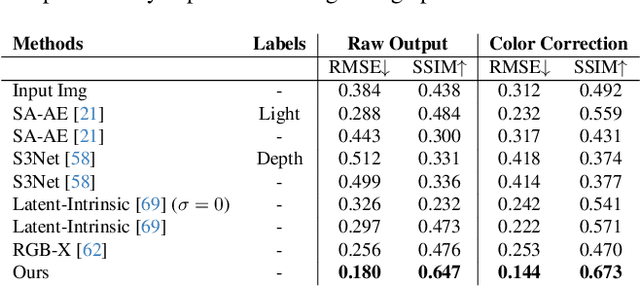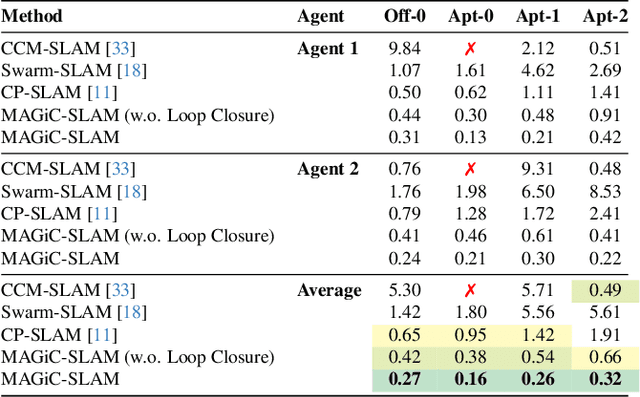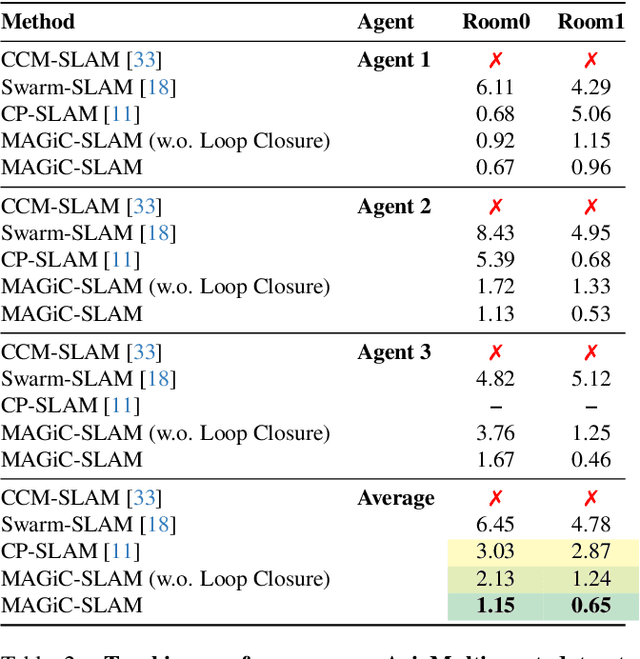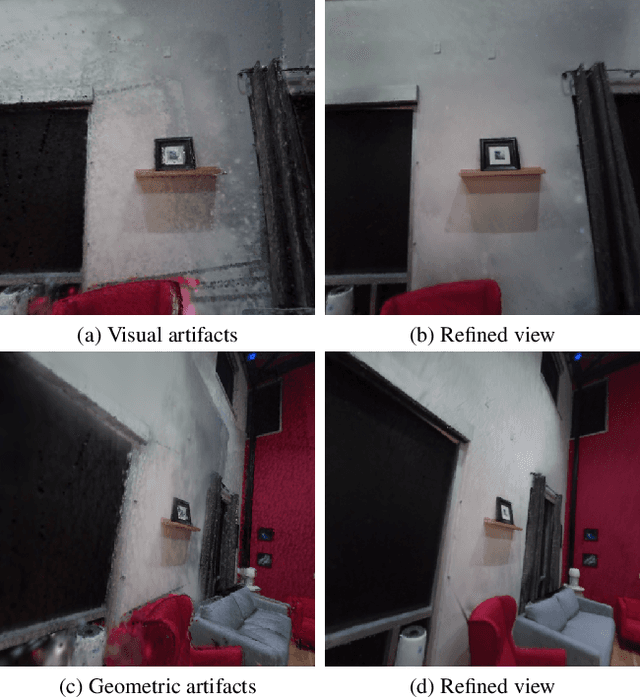Theo Gevers
SceneSplat++: A Large Dataset and Comprehensive Benchmark for Language Gaussian Splatting
Jun 10, 2025Abstract:3D Gaussian Splatting (3DGS) serves as a highly performant and efficient encoding of scene geometry, appearance, and semantics. Moreover, grounding language in 3D scenes has proven to be an effective strategy for 3D scene understanding. Current Language Gaussian Splatting line of work fall into three main groups: (i) per-scene optimization-based, (ii) per-scene optimization-free, and (iii) generalizable approach. However, most of them are evaluated only on rendered 2D views of a handful of scenes and viewpoints close to the training views, limiting ability and insight into holistic 3D understanding. To address this gap, we propose the first large-scale benchmark that systematically assesses these three groups of methods directly in 3D space, evaluating on 1060 scenes across three indoor datasets and one outdoor dataset. Benchmark results demonstrate a clear advantage of the generalizable paradigm, particularly in relaxing the scene-specific limitation, enabling fast feed-forward inference on novel scenes, and achieving superior segmentation performance. We further introduce GaussianWorld-49K a carefully curated 3DGS dataset comprising around 49K diverse indoor and outdoor scenes obtained from multiple sources, with which we demonstrate the generalizable approach could harness strong data priors. Our codes, benchmark, and datasets will be made public to accelerate research in generalizable 3DGS scene understanding.
Gaussian Mapping for Evolving Scenes
Jun 07, 2025Abstract:Mapping systems with novel view synthesis (NVS) capabilities are widely used in computer vision, with augmented reality, robotics, and autonomous driving applications. Most notably, 3D Gaussian Splatting-based systems show high NVS performance; however, many current approaches are limited to static scenes. While recent works have started addressing short-term dynamics (motion within the view of the camera), long-term dynamics (the scene evolving through changes out of view) remain less explored. To overcome this limitation, we introduce a dynamic scene adaptation mechanism that continuously updates the 3D representation to reflect the latest changes. In addition, since maintaining geometric and semantic consistency remains challenging due to stale observations disrupting the reconstruction process, we propose a novel keyframe management mechanism that discards outdated observations while preserving as much information as possible. We evaluate Gaussian Mapping for Evolving Scenes (GaME) on both synthetic and real-world datasets and find it to be more accurate than the state of the art.
LumiNet: Latent Intrinsics Meets Diffusion Models for Indoor Scene Relighting
Dec 03, 2024



Abstract:We introduce LumiNet, a novel architecture that leverages generative models and latent intrinsic representations for effective lighting transfer. Given a source image and a target lighting image, LumiNet synthesizes a relit version of the source scene that captures the target's lighting. Our approach makes two key contributions: a data curation strategy from the StyleGAN-based relighting model for our training, and a modified diffusion-based ControlNet that processes both latent intrinsic properties from the source image and latent extrinsic properties from the target image. We further improve lighting transfer through a learned adaptor (MLP) that injects the target's latent extrinsic properties via cross-attention and fine-tuning. Unlike traditional ControlNet, which generates images with conditional maps from a single scene, LumiNet processes latent representations from two different images - preserving geometry and albedo from the source while transferring lighting characteristics from the target. Experiments demonstrate that our method successfully transfers complex lighting phenomena including specular highlights and indirect illumination across scenes with varying spatial layouts and materials, outperforming existing approaches on challenging indoor scenes using only images as input.
MAGiC-SLAM: Multi-Agent Gaussian Globally Consistent SLAM
Nov 25, 2024



Abstract:Simultaneous localization and mapping (SLAM) systems with novel view synthesis capabilities are widely used in computer vision, with applications in augmented reality, robotics, and autonomous driving. However, existing approaches are limited to single-agent operation. Recent work has addressed this problem using a distributed neural scene representation. Unfortunately, existing methods are slow, cannot accurately render real-world data, are restricted to two agents, and have limited tracking accuracy. In contrast, we propose a rigidly deformable 3D Gaussian-based scene representation that dramatically speeds up the system. However, improving tracking accuracy and reconstructing a globally consistent map from multiple agents remains challenging due to trajectory drift and discrepancies across agents' observations. Therefore, we propose new tracking and map-merging mechanisms and integrate loop closure in the Gaussian-based SLAM pipeline. We evaluate MAGiC-SLAM on synthetic and real-world datasets and find it more accurate and faster than the state of the art.
FewViewGS: Gaussian Splatting with Few View Matching and Multi-stage Training
Nov 04, 2024



Abstract:The field of novel view synthesis from images has seen rapid advancements with the introduction of Neural Radiance Fields (NeRF) and more recently with 3D Gaussian Splatting. Gaussian Splatting became widely adopted due to its efficiency and ability to render novel views accurately. While Gaussian Splatting performs well when a sufficient amount of training images are available, its unstructured explicit representation tends to overfit in scenarios with sparse input images, resulting in poor rendering performance. To address this, we present a 3D Gaussian-based novel view synthesis method using sparse input images that can accurately render the scene from the viewpoints not covered by the training images. We propose a multi-stage training scheme with matching-based consistency constraints imposed on the novel views without relying on pre-trained depth estimation or diffusion models. This is achieved by using the matches of the available training images to supervise the generation of the novel views sampled between the training frames with color, geometry, and semantic losses. In addition, we introduce a locality preserving regularization for 3D Gaussians which removes rendering artifacts by preserving the local color structure of the scene. Evaluation on synthetic and real-world datasets demonstrates competitive or superior performance of our method in few-shot novel view synthesis compared to existing state-of-the-art methods.
SDFit: 3D Object Pose and Shape by Fitting a Morphable SDF to a Single Image
Sep 24, 2024Abstract:We focus on recovering 3D object pose and shape from single images. This is highly challenging due to strong (self-)occlusions, depth ambiguities, the enormous shape variance, and lack of 3D ground truth for natural images. Recent work relies mostly on learning from finite datasets, so it struggles generalizing, while it focuses mostly on the shape itself, largely ignoring the alignment with pixels. Moreover, it performs feed-forward inference, so it cannot refine estimates. We tackle these limitations with a novel framework, called SDFit. To this end, we make three key observations: (1) Learned signed-distance-function (SDF) models act as a strong morphable shape prior. (2) Foundational models embed 2D images and 3D shapes in a joint space, and (3) also infer rich features from images. SDFit exploits these as follows. First, it uses a category-level morphable SDF (mSDF) model, called DIT, to generate 3D shape hypotheses. This mSDF is initialized by querying OpenShape's latent space conditioned on the input image. Then, it computes 2D-to-3D correspondences, by extracting and matching features from the image and mSDF. Last, it fits the mSDF to the image in an render-and-compare fashion, to iteratively refine estimates. We evaluate SDFit on the Pix3D and Pascal3D+ datasets of real-world images. SDFit performs roughly on par with state-of-the-art learned methods, but, uniquely, requires no re-training. Thus, SDFit is promising for generalizing in the wild, paving the way for future research. Code will be released
RealDiff: Real-world 3D Shape Completion using Self-Supervised Diffusion Models
Sep 16, 2024Abstract:Point cloud completion aims to recover the complete 3D shape of an object from partial observations. While approaches relying on synthetic shape priors achieved promising results in this domain, their applicability and generalizability to real-world data are still limited. To tackle this problem, we propose a self-supervised framework, namely RealDiff, that formulates point cloud completion as a conditional generation problem directly on real-world measurements. To better deal with noisy observations without resorting to training on synthetic data, we leverage additional geometric cues. Specifically, RealDiff simulates a diffusion process at the missing object parts while conditioning the generation on the partial input to address the multimodal nature of the task. We further regularize the training by matching object silhouettes and depth maps, predicted by our method, with the externally estimated ones. Experimental results show that our method consistently outperforms state-of-the-art methods in real-world point cloud completion.
Ray-Distance Volume Rendering for Neural Scene Reconstruction
Aug 28, 2024Abstract:Existing methods in neural scene reconstruction utilize the Signed Distance Function (SDF) to model the density function. However, in indoor scenes, the density computed from the SDF for a sampled point may not consistently reflect its real importance in volume rendering, often due to the influence of neighboring objects. To tackle this issue, our work proposes a novel approach for indoor scene reconstruction, which instead parameterizes the density function with the Signed Ray Distance Function (SRDF). Firstly, the SRDF is predicted by the network and transformed to a ray-conditioned density function for volume rendering. We argue that the ray-specific SRDF only considers the surface along the camera ray, from which the derived density function is more consistent to the real occupancy than that from the SDF. Secondly, although SRDF and SDF represent different aspects of scene geometries, their values should share the same sign indicating the underlying spatial occupancy. Therefore, this work introduces a SRDF-SDF consistency loss to constrain the signs of the SRDF and SDF outputs. Thirdly, this work proposes a self-supervised visibility task, introducing the physical visibility geometry to the reconstruction task. The visibility task combines prior from predicted SRDF and SDF as pseudo labels, and contributes to generating more accurate 3D geometry. Our method implemented with different representations has been validated on indoor datasets, achieving improved performance in both reconstruction and view synthesis.
Geometry-guided Feature Learning and Fusion for Indoor Scene Reconstruction
Aug 28, 2024Abstract:In addition to color and textural information, geometry provides important cues for 3D scene reconstruction. However, current reconstruction methods only include geometry at the feature level thus not fully exploiting the geometric information. In contrast, this paper proposes a novel geometry integration mechanism for 3D scene reconstruction. Our approach incorporates 3D geometry at three levels, i.e. feature learning, feature fusion, and network supervision. First, geometry-guided feature learning encodes geometric priors to contain view-dependent information. Second, a geometry-guided adaptive feature fusion is introduced which utilizes the geometric priors as a guidance to adaptively generate weights for multiple views. Third, at the supervision level, taking the consistency between 2D and 3D normals into account, a consistent 3D normal loss is designed to add local constraints. Large-scale experiments are conducted on the ScanNet dataset, showing that volumetric methods with our geometry integration mechanism outperform state-of-the-art methods quantitatively as well as qualitatively. Volumetric methods with ours also show good generalization on the 7-Scenes and TUM RGB-D datasets.
ShapeSplat: A Large-scale Dataset of Gaussian Splats and Their Self-Supervised Pretraining
Aug 20, 2024



Abstract:3D Gaussian Splatting (3DGS) has become the de facto method of 3D representation in many vision tasks. This calls for the 3D understanding directly in this representation space. To facilitate the research in this direction, we first build a large-scale dataset of 3DGS using the commonly used ShapeNet and ModelNet datasets. Our dataset ShapeSplat consists of 65K objects from 87 unique categories, whose labels are in accordance with the respective datasets. The creation of this dataset utilized the compute equivalent of 2 GPU years on a TITAN XP GPU. We utilize our dataset for unsupervised pretraining and supervised finetuning for classification and segmentation tasks. To this end, we introduce \textbf{\textit{Gaussian-MAE}}, which highlights the unique benefits of representation learning from Gaussian parameters. Through exhaustive experiments, we provide several valuable insights. In particular, we show that (1) the distribution of the optimized GS centroids significantly differs from the uniformly sampled point cloud (used for initialization) counterpart; (2) this change in distribution results in degradation in classification but improvement in segmentation tasks when using only the centroids; (3) to leverage additional Gaussian parameters, we propose Gaussian feature grouping in a normalized feature space, along with splats pooling layer, offering a tailored solution to effectively group and embed similar Gaussians, which leads to notable improvement in finetuning tasks.
 Add to Chrome
Add to Chrome Add to Firefox
Add to Firefox Add to Edge
Add to Edge